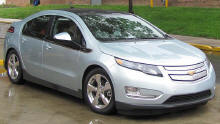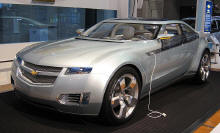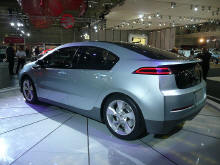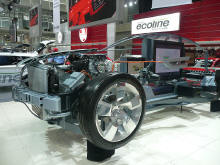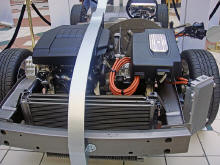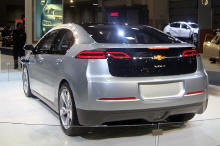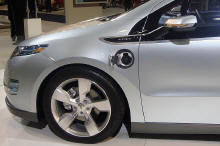Chevy Volt
The Chevrolet Volt is a plug-in hybrid electric vehicle to be produced by the Chevrolet division of General Motors and expected to be launched in November 2010 as a 2011 model. Its propulsion system will be based on GM's new Voltec (formerly known as E-Flex) electric automobile platform, which differs significantly from GM's earlier BAS Hybrid and Two-Mode Hybrid systems. For up to the first 40 miles (64 km), the Volt is powered by electrical energy stored in its on-board lithium-ion batteries which are charged by connection to an electrical power outlet. The car's 16 kW·h (8.8 kW·h usable) lithium-ion battery pack can be fully charged by plugging the car into a 120-240VAC residential electrical outlet using the provided SAE J1772-compliant charging cord. No external charging station will be required. With fully charged batteries, enough electrical energy will be stored to power the Volt up to 40 miles (64 km). This distance is capable of satisfying the daily commute for 75% of Americans, whose commute is on average 33 miles (53 km). After 40 miles (64 km), a small 4-cylinder gasoline internal combustion engine creates electricity on-board using a 53 kW (71 hp) generator to extend the Volt's range to more than 300 miles (483 km). The electrical power from the generator is sent primarily to the electric motor, with the excess going to the batteries, depending on the state of charge (SoC) of the battery pack and the power demanded at the wheels. The distribution is controlled by the electronic control unit (ECU) of the vehicle. Unlike most current commercially available hybrid electric vehicles, the actual propulsion of the Volt is accomplished exclusively by the electric motor. The Volt's retail price has yet to be officially announced. Recently the Volt's vehicle line director Tony Posawatz from GM responded to the question of anticipated Volt pricing by stating "the real or effective cost to consumers is easily less than $30,000” which includes the $7,500 U.S. federal tax credit and effective savings in electricity and other benefits. Development and production of the Volt has been kept on or ahead of schedule, despite GM's Chapter 11 reorganization. The first pre-production test car based on the full Volt design was built in June 2009 in Warren, Michigan and by October 2009, 80 Volts had been built and are being tested under various conditions. On March 31, 2010 the first factory-built Volt was produced at the Detroit Hamtramck Assembly Plant in order to test the production line and for quality control purposes, both of the tooling and the pre-production vehicles that will be produced before regular production begins. Classification as a "hybrid"Because the current Society of Automotive Engineers (SAE) definition of a hybrid vehicle states the vehicle shall have "two or more energy storage systems both of which must provide propulsion power, either together or independently," the company has avoided the use of the term "hybrid" when describing its Voltec designs. Instead GM describes the Volt as an electric vehicle equipped with a "range extending" gasoline powered internal combustion engine (ICE) as a genset and therefore dubbed an "Extended Range Electric Vehicle" or E-REV. However, due to the combination of an internal combustion engine and electric motors in series rather than parallel, this configuration is most commonly referred to as a plug-in series hybrid. See Hybrid vehicle drivetrain. DesignThe Volt concept vehicle has four doors with a rear liftgate, and is capable of carrying four passengers. This is a significant change in design when compared to the General Motors EV1 of the 1990s, which only seated two to reduce weight. The top speed has also been increased on the Volt, from the electronically limited 80 miles per hour (130 km/h) to 100 miles per hour (160 km/h). The battery pack size has also been reduced, from about 300 L in volume in the EV1, to just 100 L in the Volt. GM's Vice Chairman Robert Lutz told Newsweek in 2007 that a two-seat sports car by Tesla Motors, the Roadster, and the rapid advancement of battery technology inspired him to push GM to develop the Volt. Production modelThe production design model, first revealed to the public on September 16, 2008, differs greatly in design from the original concept car. Citing necessary aerodynamic changes needed to extend the Volt's initial full-charge range, the Volt uses GM's new "Delta II" platform, shared by the planned 2010 Chevrolet Cruze and the 2011 Saab 9-3. Although GM has not publicly revealed the production model's drag coefficient, they claim it will be lower than the 0.25 drag coefficient of the Toyota Prius, which uses a Kammback body. Electromechanical design timelineGM executives report that battery technology will have a large impact in determining the success of the car. To help spur battery research, GM selected two companies to provide advanced lithium-ion battery packs: Compact Power (CPI), which uses manganese spinel based cells made by its parent company, LG Chemical; and Continental Automotive Systems, which uses nanophosphate based cylindrical cells made by A123Systems. However, on August 9, 2007, GM established a more close-knit relationship with A123Systems so that the two companies could co-develop a Volt-specific battery cell. This cell was later unveiled at the EVS23 industry convention in Anaheim, CA. Work with CPI has continued at a rapid pace, and in late 2007 CPI delivered two fully-functional prototype battery packs to GM's testing facilities. On January 31, 2008, A123 and Continental delivered their first prototype to GM's European test facilities. GM announced on January 12, 2009 that it would use the LG Chem batteries for the production model. GM expects ten years of life out of the batteries. As of early 2008, they had started extensive battery testing and planned to have 10-year battery results in two years. Batteries were placed in the Chevrolet Malibu for further real-world testing. In April 2008, GM Vice Chairman Bob Lutz said that the first battery test mule was now running with a lithium-ion battery pack. By that summer, GM confirmed that a non-turbocharged, 1.4 liter 4-cylinder engine would be used as the range extender, and that the intention is to build it in Flint, Michigan. In August 2008, Andrew Farah, the car's chief engineer, stated that the project remains on-track to hit the 2010 deadline saying "at this point, there’s nothing standing in our way of continuing to do what we said we’re going to do." In April 2009, GM allowed journalists to test the Volt powertrain in the body of Chevrolet Cruze sedans used as test mules which lacked the range-extending generator. The driving tests were conducted at GM Technical Center in Warren, Michigan. Several of the journalists noted that the Volt mule's drive in electric mode is quiet and smooth, without any of the typical noises in commercially available hybrids when accelerating or decelerating. In November 2009, a journalist described the 'feel' of driving the car as it transitioned from electric to generator mode as "the engine’s initial engagement is inaudible and seamless" GM plans to include in the Volt some type of noisemaker to alert blind pedestrians of the car's presence. The first integration prototype based on the final Volt design was built in June 2009, in Warren, Michigan. By October, 80 Volts had been built and tested in various conditions, and by October 2009, GM expects 80 of them to be on the road as press cars and test vehicles. DrivetrainThe 2007 Chevrolet Volt concept vehicle that appeared in the North American International Auto Show introduced the Voltec drive system, which is an attempt to standardize many components of possible future electrically-propelled vehicles, and to allow multiple interchangeable electricity-generating systems. The initial design as envisioned in the Volt combines an electric motor and 16 kW·h (58 MJ) lithium-ion battery plug-in system with a small 1.0 L engine powered by gasoline linked to a 53 kW (71 hp) generator. The vehicle is propelled by an electric motor with a peak output of 120 kW (160 hp). Ordinarily, the vehicle would be charged while at home overnight. According to General Motors a full charge will take approximately eight hours from a standard North American 120 V, 15 A household outlet and less than three hours if using a standard 240 VAC outlet. Charge times will be less if the battery is not fully depleted when charging commences. Since the electrical drivetrain is not affected by the method used to charge its batteries, several options could be available for an engine. The original prototype specifications for the Volt indicated a turbo-charged 1.0 litre 3-cylinder engine would be used. However the initial production configuration currently specified by GM indicates the use of a naturally aspirated 1.4-liter 4-cylinder gasoline engine (Opel's Family 0). The Volt will be E85 flex-fuel capable about a year after its introduction. This drivetrain layout is considered a plug-in series hybrid design since mechanical power drives the generator, which in turn either charges the battery pack or provides power to the electric motor. While the ICE has an electrical connection with the electric motor and hence the wheels, there is no mechanical linkage to the wheels (unlike current automobile hybrid vehicles such as the Toyota Prius), allowing optimization of engine rpm for fuel consumption, efficient rate of charge, and low emissions. GM plans to station charge the lithium-ion battery to a state-of-charge (SoC) range of approx 85%. Then once the battery depletes to a precise low set-point (<25%) the on-board ICE powered generator will maintain the state of charge of the battery between the lower setpoint and an upper set-point above the 30% SoC level. GM has decided on a new descriptive terminology to distinguish it from traditional hybrids. They are calling the Volt an E-REV, for extended-range electric vehicle, although it still qualifies as a hybrid. Production and salesIn July 2007, General Motors stated that it would have the Volt on the U.S. market in 2010, and in early June 2008, they confirmed that production had been approved, with a target of getting the Volt into showrooms by the end of 2010. Following the conclusion of the 2007 UAW-GM contract talks, assembly of the Volt was assigned to Detroit/Hamtramck Assembly. Initially the gasoline engine will be imported from the Opel engine plant in Aspern, Austria. Early estimates, from GM staff, were of initial annual production of 60,000 units, but these claims have been scaled back to a planned 10,000 units, as of May 2008, with a ramp up to 60,000 units in the second year. At the 2009 Frankfurt Auto Show Opel/Vauxhall showed the Ampera version of the Chevrolet Volt. Tax creditsIn the U.S. market, the price of the Volt is expected to be around US$40,000 and due to the capacity of the Volt's battery pack it qualifies for the maximum US$7,500 federal tax credit as specified in the Emergency Economic Stabilization Act of 2008. Initially, the former GM vice president Bob Lutz wanted the Volt at about $30,000. The Volt is being endorsed by Dalton McGuinty and the Ontario government in Canada. The province will provide a $10,000 subsidy, and will purchase 500 Volts for the Ontario Public Service fleet. The subsidies are part of McGuinty's target to have electric vehicles make up 5% of all cars in Ontario by 2020. Production and sales in foreign marketsAt the British International Motor Show in July 2008, GM stated that they were considering building all of the Volts for the European market, branded Chevrolet, Opel and Vauxhall, at their Vauxhall plant in Ellesmere Port on the other side of the River Mersey to the Jaguar car plant in Liverpool, United Kingdom. In August 2008 GM stated that the Volt would be available for sale in Europe in 2011. In the UK market the indicated price is around GB£20k. In late January 2009, Opel announced that its version of the Volt, the Opel Ampera, will be unveiled at the Geneva Auto Show in March. The price is still not yet firm but could land around EUR€40,000. The planned employment of the Opel Ampera should demand only an extremely low annual car tax of about EUR€28 in Germany. Opel is developing the battery control modules for the Opel Ampera at LG in Mainz-Kastel. In Asian markets, the car will be known as the Chevy Ohm. A special version for Arabic countries, called the Ohma, is being considered. At the Sydney Motor Show in October 2008, Holden stated that the Volt would be available in Australia by 2012 for "more than AUD$30,000". MarketingGM has promoted the Volt through a viral marketing campaign in which the number 230 was promoted without explanation. On August 11, 2009, GM announced the Volt can achieve a US EPA 'City' rating of 230 mpg-US (1.0 L/100 km; 280 mpg-imp) plus 25 kW·h/100 mi (560 kJ/km) using the EPA's proposed method for evaluating plug-in hybrids. Fuel efficiencyFor trips less than about 40 miles (64 km), a fully charged Chevy Volt may travel using just stored electricity and not require any on-board gasoline. This is referred to as Charge Depletion (CD) mode and the Volt is expected to use approximately 25 kW·h/100 mi on the city cycle of the EPA's test while operating in this mode. Once the Volt's battery has discharged to the estimated 30% lower State of Charge (SoC) limit, the engine starts and supplies power to the electric motor to continue driving the car and maintains the battery charge at 30%. The Volt's range-extending gasoline engine is expected to get approximately 50 mpg-US (4.7 L/100 km; 60 mpg-imp) on the city cycle of the EPA's test while operating in this Charge Sustaining (CS) mode. On August 11, 2009, GM released their estimated EPA city fuel economy rating for the Volt of 230 mpg-US (1.0 L/100 km; 280 mpg-imp) of gasoline plus 25 kW·h/100 mi (160 km) of electricity. The U.S. Environmental Protection Agency (EPA) issued a statement clarifying that the "EPA has not tested a Chevy Volt and therefore cannot confirm the fuel economy values claimed by GM." The Volt, however, can use both gasoline and grid electricity; thus, assigning a fuel economy value that only refers to on-board gasoline would not be appropriate. The EPA is working on an updated methodology for determining and then reporting the fuel economy of PHEVs. An EPA presentation to the Society of Automotive Engineers in February, 2009 discussed a method based on SAE J1711 to combine the gasoline fuel economy with the electrical fuel economy using the petroleum equivalency factor of 33.7 kW·h⁄gallonUS (the lower heating value of gasoline and the value used by the DOE) which would combine GM's estimated city fuel economies for the Volt into an overall 85 mpgge for reporting. BatteryReuters reported in October, 2008 that GM had decided to work exclusively with Compact Power Incorporated (CPI), a Detroit-based unit of South Korea’s LG Chem, to develop the battery systems for the first production version of the Volt.The cells will be produced in Korea and subsequently shipped to the United States, where the battery packs will be assembled at a purpose-built facility in Brownstown Township, Michigan owned and operated by GM. The Volt's 375 lb (170 kg), 220-cell lithium-ion battery (Li-ion) pack is anticipated to store 16 kW·h of energy, but will be restricted (in software) to use only 8.8 kW·h of this capacity to maximize the life of the pack. It will only be allowed to charge to 85% of full capacity and to discharge only to approximately 30% SoC before the engine cuts in and maintains the charge near the lower level. When the vehicle is plugged into a charger the battery SoC is restored to 85%. Despite containing near identical energy,(+/- 0.5kWh) the Volt's battery pack is over 70% lighter than the EV1's original 1,310 lb (590 kg), 16.5 kW·h AC Delco lead-acid battery pack, mainly because the Volt will use higher specific energy Li-ion batteries. Li-Ion batteries are expected to become less expensive as economies of scale take effect. The battery needs a minimum temperature of between 0 °C and 10 °C (32 °F and 50 °F) to be used and when the Volt is plugged in the battery will be kept warm enough so that it can be used immediately when the Volt is unplugged. If the Volt is kept unplugged and the temperature of the battery is below the minimum temperature the gasoline engine will run until the battery warms up. This temperature regulation is done since electro-chemical batteries have degraded performance when they are very cold. Charge plug interfaceThe Volt will use a new plug specification, SAE J1772-2009, that is being proposed as a standard for electric cars. Regulated emissions impactIt is anticipated that the Chevrolet Volt will be granted a California Air Resources Board (CARB) classification as an Advanced Technology Partial zero-emissions vehicle (AT-PZEV). Assuming a fully charged battery, the Volt will use no gasoline and produce no tailpipe emissions for up to 40 miles (64 km) of initial daily driving. However, after 40 miles (64 km), the state-of-charge (SOC) of the HV battery will be depleted and the internal combustion engine (ICE) will start up to commence power generation. During this period, using typical closed-loop fueling and exhaust after treatment (i.e. catalytic converter) the tail-pipe exhaust emissions will be similar to other 4-cyl low displacement gasoline-powered automobiles. However, once a sufficient battery state-of-charge has been achieved, the ICE will again turn off,returning to a zero emissions state. This ON:OFF ICE cycling behavior results in the reduction of Initial Trip Starts and therefore a reduction in total tailpipe emissions per distance travelled. OnStar MobileThe Volt will feature Onstar Mobile for owners to access vehicle information without being in or near the car. The smart phone application features the ability to check fuel efficiency as well as the vehicles current electric range. It will also help monitor the charging, giving owners key information about the current charge level and the amount of time it will take until it’s fully charged. The application will be able to control features such as locking/unlocking doors and can act as a remote car starter. Volt MPV5At the 2010 Auto China auto show GM showed the 2011 Chevrolet Volt MPV5 Concept. The Volt MPV5 has a top speed of 100 mph and has an electric range of 32 miles. ControversiesAs of September 2008, General Motors was reportedly in disagreement with the United States Environmental Protection Agency regarding how the Volt should be tested to determine its official fuel economy rating. The EPA reportedly wants to alter the method of testing currently used for all other hybrid vehicles. If tested with the same EPA tests used by other hybrids, the Volt's ability to use the energy stored in the batteries would result in it achieving a fuel economy rating of over 100 mpg, which would make the Volt the first mass-produced automobile to achieve such a rating. General Motors believes that although the Volt is an entirely new type of vehicle, it suggests that altering the current EPA hybrid testing methods to suit a single vehicle entry would be unfair and would not recognize the fact that the car can travel an estimated 40 miles (64 km) on battery power alone before the gasoline powered engine has to be started to commence recharging its battery pack. CostIn 2009, the Presidential Task Force on the Auto Industry said that "GM is at least one generation behind Toyota on advanced, “green” powertrain development. In an attempt to leapfrog Toyota, GM has devoted significant resources to the Chevy Volt." and that "while the Chevy Volt holds promise, it is currently projected to be much more expensive than its gasoline-fueled peers and will likely need substantial reductions in manufacturing cost in order to become commercially viable." Earlier in June 2008, Bob Lutz admitted the first-generation Volt with a price tag of about US$30–40,000 was not expected to generate a profit for GM. In an April 2009 interview with the president of GM's North American operations, Troy Clark stated he was uncertain if the next generation systems following the Volt would be profitable. A recent Carnegie Mellon University study indicates that a PHEV-40 will be less cost effective than a HEV or a PHEV-7 in all of the scenarios considered, due to the cost and weight of the battery. Jon Lauckner, a Vice President at GM, responded that the study did not consider the inconvenience of a 7 mile electric range and that the study's cost estimate for the Volt's battery pack was "many hundreds of dollars per kilowatt hour higher" than what it costs to make today. Battery charging emissionsCharging the Volt's batteries still results in some greenhouse gas emissions from electrical generation at the local power station. However, under most conditions CO2 output is less than other low emission vehicles and in the best case emissions are nearly zero. GM claims that the Volt saves 4.4 metric tons in CO2 emissions annually compared to a typical U.S. car. In locations such as , where there is a high level of constant electric generation due to a high mix of nuclear power generation and large-scale hydro-electric power generation, much of the power goes to "waste" in off-peak times as generation exceeds the baseload due to the impracticality of scaling back the output of a CANDU reactor or hydro-electric plant on an hour-by-hour basis. In Ontario, baseload demand varies between 12000 and 15000 MW depending on season while the total generation by nuclear and hydroelectric plants (when all are in operation) accounts for over 19000 MW. In this jurisdiction and other similar ones, electric vehicles which are charged during off-peak times result in zero additional pollution. The University of California, Davis calculated that, generally, plug-in cars that are charged using electricity from the local grid will emit notably less CO2 overall than the use of cars powered from on-board, oil-based fuel, if a significant proportion of that electricity is generated from nuclear power and renewable sources such as hydro-electric (45% in California, for example). UK based Auto Express magazine claims in a non-scientific study to have calculated that the generation of electricity for charging the batteries in the Volt resulted in emissions equivalent to 124.2 g/km of CO2 for electric-only trips (those not involving the use of any on board fuel), based on government figures for the average CO2 emissions from power stations. No calculations are shown in the article, so the veracity of this claim cannot be evaluated. According to Auto Express, this is more CO2 than the BMW 118d produces. Using CO2 emissions data for the United States, the Auto Express estimate can be shown to imply Volt's plug-to-wheel efficiency of approximately 340 Wh/mile - somewhat high for electric vehicles (Tesla Roadster is EPA rated at 280 Wh/mile plug-to wheel), but within the realm of possibility. A study by the American Council for an Energy Efficient Economy (ACEEE) predicts that, on average, a typical plug-in hybrid electric vehicle is expected to achieve about a 15% reduction in net CO2 emissions compared to the driver of a regular hybrid, based on the 2005 distribution of power sources feeding the U.S. electrical grid. The ACEEE study also predicts that in areas where less than 80% of grid-power comes from coal-burning power plants, local net CO2 emissions will decrease, but points out that these numbers are first order estimates and are not conclusive. In Australia, where 85% of electricity nationally is produced using black and brown coal, with most of the remainder produced using hydro and natural gas, the greenhouse emission factors vary between states, and is 1.22 kg-CO2e/kW·h in Victoria, 0.890 kg-CO2e/kW·h in New South Wales, and 0.120 kg-CO2e/kW·h in Tasmania. Assuming a charge requires 8.8 kW·h, allowing 40 miles (64 km) of travel without petrol, the greenhouse intensities are 167 g-CO2e/km for Victoria, 122 g-CO2e/km for NSW, and 16 g-CO2e/km for Tasmania. Electricity consumers can elect to purchase green power at a higher cost, but with significantly lower emissions. For comparative purposes using the same methodology, that is, measuring only the direct emissions from the burning of the fuel, and ignoring fuel procurement/production/delivery, the Toyota Prius tank-to-wheel greenhouse intensity in units of g-CO2 (CO2e information not available) in Australia is 115 g/km (5.1 l/100 km combined cycle), Toyota Yaris 1.3 manual is 141 g/km (6.0 l/100 km combined cycle), and the BMW 120d is 162 g/km (6.1 l/100 km combined cycle). It should be noted that this comparison is not the standard method used by government agencies for comparing the emissions of two vehicles, where the tank-to-wheel only is used; in this case, the Volt would be emission-free for the 40-mile all-electric range (AER). The above comparison does not include the full fuel cycle for either vehicle, known as a well-to-wheel analysis, and so the numbers may be slightly misleading. Awards
|
||||||||||||||||||||||||||||||||||||

